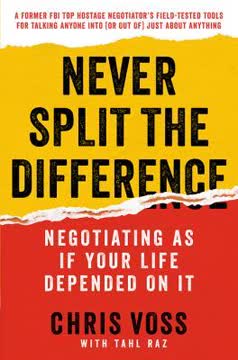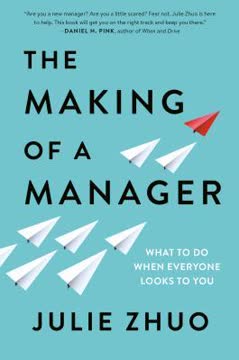Key Takeaways
1. Focus on What Truly Matters to Maximize Impact
Constantly have a razor-sharp awareness of what you are doing and how it is adding value to you or to your problems.
Prioritization is key. In a world of endless tasks, focusing on what truly matters is paramount. This involves a constant evaluation of activities to ensure they align with core objectives and deliver tangible value. Leaders must discern between urgent and important tasks, prioritizing those that contribute most significantly to desired outcomes.
Methods for prioritization:
- Sense of Urgency: Address items with tighter deadlines first.
- Critical Path Analysis: Identify the sequence of tasks essential to achieving the goal.
- Financial Impact: Focus on activities directly linked to financial outcomes or key performance indicators (KPIs).
Industry-specific focus. What matters most varies across industries. For automotive, it's safety and design; for pharmaceuticals, it's drug effectiveness. By understanding the core drivers of success in a given field, leaders can concentrate their efforts on the areas that yield the greatest return.
2. Prioritize Difficult Tasks Early for Peak Productivity
Work on the hard and painful tasks in the morning to deliver productive output.
Early bird advantage. The early morning hours offer a unique window of opportunity for focused work. With fewer distractions and a quieter environment, individuals can tackle challenging tasks that require full attention. This approach leverages the mind's peak performance during cooler hours.
Defining the "hard stuff":
- Tasks you least want to do
- Long-term projects, not quick wins
- Work requiring full concentration
- Tasks you're unsure how to tackle
Scientific basis. Body temperature is lowest in the early morning, while mental acuity is highest. This combination makes it an ideal time for creative and demanding work. By reserving evenings for less intensive tasks, individuals can optimize their energy levels throughout the day.
3. Cultivate Sensitivity to Subtle Signals for Distinctive Leadership
Apply the Pareto analysis or 80-20 rule to your everyday life.
Pareto principle in action. The Pareto principle, or 80-20 rule, suggests that 20% of inputs are responsible for 80% of results. Applying this principle to leadership involves identifying the small signals that can make a significant difference. This requires a keen awareness of one's strengths and how they can be leveraged for maximum impact.
Beyond problem-solving. While the Pareto principle is often used in problem-solving, it can also be applied to day-to-day life and career development. This involves recognizing opportunities to make a disproportionate impact with minimal effort.
Examples of catching small signals:
- Offering help to a distressed client, even if they're not a core team member
- Noticing a colleague's discomfort and offering support
- Identifying a small process improvement that can save significant time
4. Master Concise Communication for Executive Impact
Form an answer beforehand by mastering the “double-clicking” technique and coming up with short answers.
The 30-second answer. In high-stakes environments, the ability to communicate concisely is crucial. This involves mastering the "double-clicking" technique, which provides just enough information to pique interest without overwhelming the listener. Tailoring answers to the audience is also essential.
Breaking down the question:
- What is the overall project status?
- What are supporting examples?
- What is the plan to address problems?
- How can the executive help?
Dartboard approach. Think of your answer like a dartboard, starting from the outermost ring and honing in on the center. This involves preempting potential questions and providing cues that allow the listener to guide the conversation.
5. Frontload Projects to Build Early Trust and Momentum
Build the necessary trust and credibility by completing work as much as possible during the first week, following the basket of essentials.
First impressions matter. The first week of a project is critical for establishing trust and credibility. By frontloading work and demonstrating a fast learning curve, leaders can set a positive tone and build confidence among stakeholders. This involves preparing a "basket of essentials" to address key areas.
Basket of essentials:
- Secure time with senior leaders
- Complete the end story line upfront
- Answer burning questions
- Conduct due diligence on team members
- Organize necessary meetings
- Delegate non-essential tasks
Fast learners thrive. Demonstrating the ability to quickly learn, apply knowledge, and take command is highly valued in today's dynamic business environment. Frontloading projects is a clear sign of future leadership potential.
6. Embrace Stress with a Smile to Maintain Composure
During stressful meetings, keep on smiling to reduce your stress and stay focused on getting the work done.
Smiling under fire. In high-pressure situations, maintaining composure is essential. Smiling, even when under stress, can reduce tension and promote a more positive mindset. This involves answering key questions to reframe the situation.
Questions to reframe stress:
- What is the big picture?
- Are we solving the same issue from different angles?
- Can I separate the problem from the person?
- What is the root cause of the hostility?
Scientific benefits. Smiling reduces stress and creates positive emotions. It also encourages nodding, which signals acknowledgment and reduces anger. However, it's important to ensure the smile is genuine and appropriate for the situation.
7. Imagine Worst-Case Scenarios to Drive Proactive Planning
Imagining the worst-case scenario will enable you to make decisions more quickly and think about the next-step actions.
Overcoming fear of failure. The fear of failure can be paralyzing. By imagining the worst-case scenario, leaders can prepare themselves emotionally and develop contingency plans. This allows for quicker decision-making and more effective action when problems arise.
Countermeasure-driven approach. Great leaders don't just fight fires; they anticipate them. This involves developing countermeasures and problem-solving strategies in advance. This proactive approach allows for a more controlled and effective response to challenges.
Benefits of defining worst-case scenarios:
- Improved emotional control
- Broader perspective
- Proactive risk mitigation
8. Question More, Talk Less, to Unlock Deeper Understanding
Grow by questioning and listening more to other people the way principals and successful entrepreneurs do.
Inquisitive mindset. Successful leaders are often characterized by their curiosity and willingness to learn. This involves asking more questions and talking less, creating space for others to share their insights and perspectives. This approach fosters a deeper understanding of complex issues.
Benefits of questioning:
- Makes others feel valued and empowered
- Facilitates knowledge acquisition
- Enhances listening skills
Active listening. Beyond simply hearing words, active listening involves fully engaging with the speaker and seeking to understand their perspective. This requires empathy, patience, and a willingness to set aside one's own agenda.
9. Turn "No" into "Yes" Through Suggestive Inquiry
Rather than correcting people impulsively, try to help them correct themselves by using suggestive questions.
Avoiding direct opposition. In many situations, directly refuting someone's statement can be counterproductive. A more effective approach involves using suggestive questions to guide them toward a more accurate understanding. This preserves their dignity and encourages self-correction.
Benefits of suggestive questions:
- Reduces conflict
- Preserves relationships
- Encourages self-discovery
The art of inquiry. This technique requires patience, empathy, and a willingness to let go of the need to be "right." By asking thoughtful questions, leaders can create a more collaborative and productive environment.
10. Give Knowledge Freely to Foster Growth and Reciprocity
Put the “pay it forward economics” in full throttle to make others successful around you.
Pay-it-forward economics. Sharing knowledge and tools freely creates a culture of reciprocity and growth. This involves willingly giving away expertise, resources, and support to help others succeed. This approach fosters a sense of community and encourages collaboration.
Benefits of giving:
- Enhances self-improvement
- Creates a positive work environment
- Attracts talent and fosters loyalty
Strategic giving. While giving freely is important, it's also essential to be strategic. This involves identifying opportunities to share knowledge that will not only benefit others but also enhance your own skills and expertise.
11. Prepare for Continuous Renewal to Thrive in Change
Become resilient, adaptable, and forgiving toward both the changes you want and the changes that are inflicted upon you.
Embracing change. In today's rapidly evolving world, the ability to adapt and reinvent oneself is crucial. This involves being resilient in the face of setbacks, forgiving of past mistakes, and open to new opportunities. This requires a willingness to redefine oneself and one's priorities.
Shifting priorities. As individuals progress through different stages of life, their values and priorities often change. This may involve shifting focus from career advancement to family, interests, or societal contributions.
Key elements of renewal:
- Resilience
- Adaptability
- Forgiveness
12. Define Your Leadership Profile to Guide Your Journey
Know the ultimate requirements for you to become a leader.
Self-awareness is key. Understanding one's strengths, weaknesses, and values is essential for effective leadership. This involves creating a personal leadership profile that outlines the attributes and qualities that define your approach. This profile serves as a guide for personal and professional development.
Four dimensions of leadership:
- Incredible with people
- Problem-solving maestro
- Great at getting stuff done
- Entrepreneurial
Continuous improvement. The journey to leadership is ongoing. By continuously reflecting on one's progress and seeking feedback, individuals can refine their leadership profile and maximize their impact.
Last updated:
FAQ
What's "The McKinsey Edge" about?
- Overview: "The McKinsey Edge" by Shu Hattori explores success principles derived from the practices and insights of McKinsey & Company, a leading global management consulting firm.
- Focus Areas: The book is structured around self-improvement, growing with others, excelling in process management, and going the extra mile.
- Practical Advice: It offers practical tips and strategies for personal and professional development, emphasizing leadership, communication, and productivity.
- Target Audience: It is aimed at aspiring leaders, managers, and anyone interested in enhancing their career and leadership skills.
Why should I read "The McKinsey Edge"?
- Proven Strategies: The book provides insights and strategies used by one of the most successful consulting firms, which can be applied to various professional contexts.
- Leadership Development: It offers guidance on developing leadership skills, which are crucial for career advancement.
- Practical Tips: The book is filled with actionable advice that can be implemented immediately to improve personal and professional effectiveness.
- Inspiration and Motivation: It includes stories and examples that can inspire and motivate readers to pursue their goals with determination.
What are the key takeaways of "The McKinsey Edge"?
- Focus on What Matters: Prioritize tasks that add the most value and align with your goals.
- Effective Communication: Use fewer words to convey more meaning and always prepare for presentations.
- Leadership and Influence: Develop the ability to lead and influence others through deliberate coaching and positive criticism.
- Continuous Improvement: Embrace iteration and feedback as tools for personal and professional growth.
What are the best quotes from "The McKinsey Edge" and what do they mean?
- "Focus on What Really Matters": This emphasizes the importance of prioritizing tasks that have the most significant impact on your goals.
- "Smile When You Are Under Stress": Suggests maintaining a positive demeanor to manage stress and influence others positively.
- "Go Beyond Your Self-Perceived Limit": Encourages pushing past perceived limitations to achieve growth and success.
- "Create a Commitment Plan": Highlights the importance of setting clear goals and sticking to them for long-term success.
How does "The McKinsey Edge" suggest improving communication skills?
- Memorize Key Sentences: Always memorize the first three sentences of a presentation to start strong and confidently.
- Use Fewer Words: Communicate using fewer words to convey more meaning and keep the audience engaged.
- Pause Before Answering: Pause three seconds before answering difficult questions to think and provide a thoughtful response.
- Ask More Questions: Encourage asking more questions and talking less to understand others better and foster meaningful conversations.
What does "The McKinsey Edge" say about leadership development?
- Role Models: Find role models to emulate and guide your leadership journey.
- On-the-Job Coaching: Create followership through deliberate on-the-job coaching and mentoring.
- Positive Criticism: Deliver feedback using positive criticism to motivate and develop team members.
- Empower Others: Assign meaningful tasks to team members to foster growth and engagement.
How can I apply the principles from "The McKinsey Edge" to my career?
- Prioritize Tasks: Focus on tasks that align with your goals and have the most significant impact.
- Develop Leadership Skills: Engage in activities that enhance your ability to lead and influence others.
- Improve Communication: Practice effective communication techniques to convey your ideas clearly and persuasively.
- Seek Continuous Improvement: Embrace feedback and iteration to refine your skills and achieve lasting growth.
What is the significance of "iteration" in "The McKinsey Edge"?
- Continuous Improvement: Iteration is emphasized as a method for refining ideas and processes to achieve better outcomes.
- Feedback Loop: It involves seeking feedback and making adjustments to improve performance and results.
- Shortening the Path to Success: Iteration is seen as the shortest way to produce long-lasting outcomes by continuously refining and improving.
- Application in Leadership: Leaders are encouraged to iterate on their strategies and approaches to adapt to changing circumstances and achieve success.
How does "The McKinsey Edge" address stress management?
- Smile Under Stress: Maintain a positive demeanor to manage stress and influence others positively.
- Worst-Case Scenario: Always imagine the worst-case scenario to prepare for challenges and reduce anxiety.
- Energy Management: Know what gives you the most energy in your day and manage your activities accordingly.
- Physical Exercise: Engage in regular physical exercise to relieve stress and maintain mental clarity.
What role does "passion" play in "The McKinsey Edge"?
- Flexible Perception: Be flexible in your perception of passion and find ways to link it to your current work.
- Energy Source: Passion is seen as a source of energy that drives motivation and engagement.
- Combination of Interests: Passion can be a combination of different interests and does not have to be singular.
- Accidental Discovery: Passion can be discovered accidentally through exploration and curiosity.
How does "The McKinsey Edge" suggest handling difficult questions?
- Pause Before Answering: Pause three seconds before answering to think and provide a thoughtful response.
- Categorize Questions: Understand the different types of questions (fact-based, discovering, evaluative, challenging) to tailor your response.
- Art of Evasion: Use the art of evasion to handle challenging questions without providing immediate answers.
- Confidence and Clarity: Maintain confidence and clarity in your responses to convey credibility and authority.
What is the "Check in and Check out" policy in "The McKinsey Edge"?
- Daily Routine: It involves checking in with your team before the day starts and checking out before it ends.
- Focus on Outcomes: The policy emphasizes focusing on outcomes rather than activities to ensure productivity.
- Prioritization: It helps prioritize tasks and identify complications early to address them effectively.
- Team Alignment: The policy ensures team alignment and clear communication of goals and deliverables.
Review Summary
The McKinsey Edge receives mixed reviews, with an average rating of 4.04 out of 5. Readers appreciate the practical advice and insights into McKinsey's work culture, highlighting tips on productivity, leadership, and personal growth. Many find the principles actionable and valuable for career development. However, some criticize the writing style, organization, and occasional outdated or obvious advice. Despite these drawbacks, most reviewers consider the book a worthwhile read for professionals seeking to improve their skills and understanding of consulting practices.
Similar Books










Download PDF
Download EPUB
.epub digital book format is ideal for reading ebooks on phones, tablets, and e-readers.




